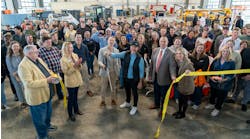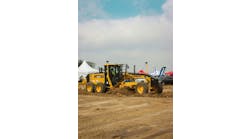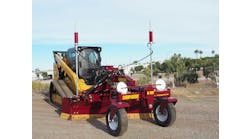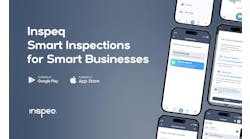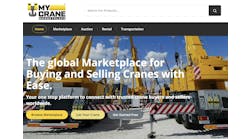What is new in your software and technology?
Hopp: InTempo has launched several new products over the last 18 months. InTempo MX (our Connected Asset solution for integrated telematics) is now available with full “due for service” tracking functionality, as well as the ability to pass data down to the end equipment user. InTempo CTX (our Connected Transport solution for integrated route and load optimization) is a few months away from general availability, bringing the first AI-driven dispatching platform directly to the equipment rental market.
And lastly, we’ve considerably upgraded the analytics experience with the launch of Reporter 5, which offers more customizable dashboards, more configurable templates, and enhanced visualization options. These technologies continue to help independent rental stores run their businesses day-to-day while working towards sustainable long-term growth.
What effects has AI had on your software and technology and what potential do you see going forward?
Hopp: AI has the potential to make the industry’s most repetitive, labor-intensive tasks easier over the coming years. Take, for instance, dispatching. Today, most rental companies have to manually review the next day’s planned deliveries and pickups, decide which drivers should handle each stop, and plot out the most logical order in which each driver should hit each jobsite. In the morning (and throughout the following day), that same team has to account for last-minute changes, communicate with drivers as unexpected challenges arise, and keep customers in the loop if their expected delivery time changes. What’s even harder? In many smaller rental businesses, the operations team in charge of this process also has non-dispatching tasks to keep up with, which means it’s often difficult just to keep their heads above water, much less invest the time required to optimize the process end-to-end.
With AI, however, algorithms can deal with prioritizing jobsites in a logical order; grouping equipment by size and weight on the corresponding vehicles; and even responding to real-time traffic and weather delays. Last-minute changes can be accommodated in seconds without having to manually re-work the entire day’s plan, and companies can reduce wasted fuel, idle time, and reliance on third-party haulers with very little effort on their part.
We see quite a few additional opportunities in the years to come, including AI-driven pricing algorithms and machine leaning for data analysis. However, it’s important to be aware that these technologies will change rental jobs rather than replace them. As technology streamlines more and more repetitive tasks, employees will be able to shift their focus on the analytical work that computers aren’t able to handle. Sales teams can work on building stronger relationships with their customers; finance teams can focus on improving their cash flow and making the strongest possible investments for their unique market; operations teams can identify better ways to streamline their day-to-day activities while providing a better overall rental experience. These tasks are highly unlikely to ever be taken over by AI, so finding ways to shift the mindset now lets companies get a head start on the next round of technological advances in the rental industry.
How important is integration of all of your systems?
Hopp: The importance can’t be overstated, honestly. In theory, it’s great to have one system as the “single source of truth” – but it’s also highly unlikely that a company will be able to use only one system for everything they need. (If they do, they’re typically sacrificing functionality for the sake of simplicity, which can end up hindering them in the end.)
Let’s take Salesforce as an example. Not every organization needs to use Salesforce, but it is one of the most commonly used software systems (especially at the enterprise level) for a reason. Integrations allow companies to use the point solutions that suit their needs the best, while still passing data back to their core rental software in real time. As long as data is passed in real time – not just once or twice a day – this lets them get the best of both worlds: critical functionality for each of their niche needs, and full visibility within their base rental software.
That same concept is why we continue to build partnerships with established partners in the rental space, including Wise Systems (the base technology on which we built InTempo CTX.) Rather than re-inventing the wheel, we’re focused on making the wheel better for rental companies. Users get faster access to much-needed technologies and get to skip much of the costly, time-consuming “trial and error” process.
What new trends in technology do you expect in the foreseeable future?
Hopp: To your point about integrations, we expect to see a continued trend toward a fully connected world. Every little part of a day-to-day rental business – from purchasing new assets and managing the corresponding paperwork to planning deliveries and managing field service – should all link back to a single source of truth. While different departments may use different ERP modules and point solutions to accomplish their goals, it all needs to tie back together to reduce wasted time and effort.
What are the most important contributions telematics makes to a rental company and how challenging is it to integrate telematics with a rental management operating system?
Hopp: Telematics – when implemented correctly and actively monitored as part of a defined strategy – can deliver major cost savings to any rental business. When technicians can remotely diagnose fault codes, they don’t have the associated cost of sending out a technician who may or may not have the correct parts in their truck for a repair; they know exactly what the issue is and what’s needed to fix it in advance. Or, better yet, they can prevent small issues from escalating to the point that they become major damage, reducing the costs of unexpected repairs overall.
Similarly, when pickup drivers can head to the exact correct location on a large jobsite, their pickup times can go from, say, 45 minutes to 20. It's also an easy way to visualize equipment that the customer has taken off rent and is no longer paying for but still needs to be picked up and brought back to the yard.
In regard to integration, it is certainly a challenge from a technical perspective – which is why we decided to partner with one of the most trusted names in telematics and build the functionality directly into InTempo. With the help of LHP Telematics, we’ve already done the hard technical work; all end users have to do is add their existing data feeds into our InTempo MX platform or add our devices to machines that aren’t already outfitted with OEM hardware. From there, the system can begin populating telematics data right next to the rental data that’s already in InTempo. The go-live process is much faster than trying to integrate something from scratch, and companies see a return on their investment more quickly as well.
What are the main concerns and issues customers in the rental industry are asking about in terms of software being able to solve their problems and help them operate more efficiently? Anything in particular that rental staff are asking for?
Hopp: Making life easier for customers continues to be a priority – especially for independent rental organizations that compete on the customer experience. Empowering customers to do as much as they can independently – from extending their rentals to paying their invoices – doesn’t just save staff time; it provides a more seamless experience that keep customers coming back for more. Additionally, companies continue to ask for simple and intuitive user interfaces. Setup and training become much faster when processes are in a logical place and buttons and menus are clearly labeled; companies can onboard new employees more quickly and get a faster return on their technology investments.

